The Kaveri Refresh 'Godavari' Review: Testing AMD's A10-7870K
by Ian Cutress on June 1, 2015 11:59 AM ESTProfessional Performance: Linux
Built around several freely available benchmarks for Linux, Linux-Bench is a project spearheaded by Patrick at ServeTheHome to streamline about a dozen of these tests in a single neat package run via a set of three commands using an Ubuntu 11.04 LiveCD. These tests include fluid dynamics used by NASA, ray-tracing, OpenSSL, molecular modeling, and a scalable data structure server for web deployments. We run Linux-Bench and have chosen to report a select few of the tests that rely on CPU and DRAM speed.
C-Ray: link
C-Ray is a simple ray-tracing program that focuses almost exclusively on processor performance rather than DRAM access. The test in Linux-Bench renders a heavy complex scene offering a large scalable scenario.
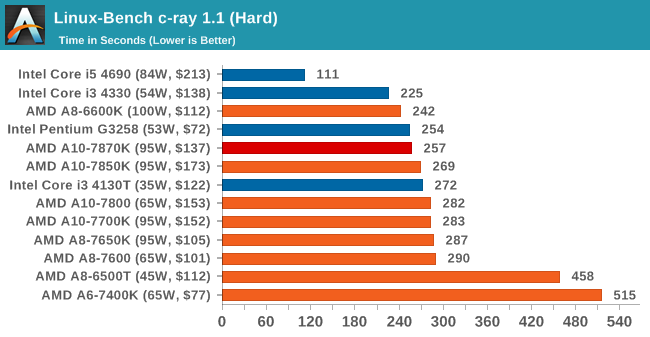
NAMD, Scalable Molecular Dynamics: link
Developed by the Theoretical and Computational Biophysics Group at the University of Illinois at Urbana-Champaign, NAMD is a set of parallel molecular dynamics codes for extreme parallelization up to and beyond 200,000 cores. The reference paper detailing NAMD has over 4000 citations, and our testing runs a small simulation where the calculation steps per unit time is the output vector.
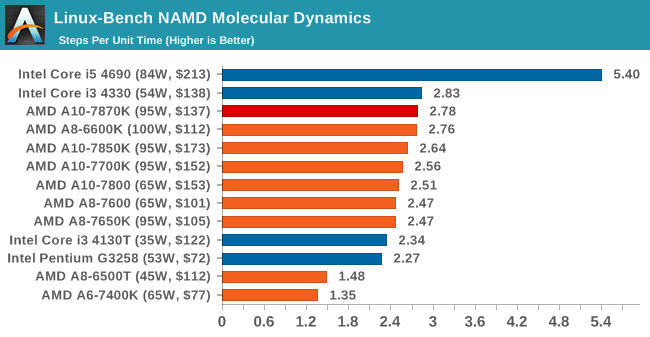
NPB, Fluid Dynamics: link
Aside from LINPACK, there are many other ways to benchmark supercomputers in terms of how effective they are for various types of mathematical processes. The NAS Parallel Benchmarks (NPB) are a set of small programs originally designed for NASA to test their supercomputers in terms of fluid dynamics simulations, useful for airflow reactions and design.
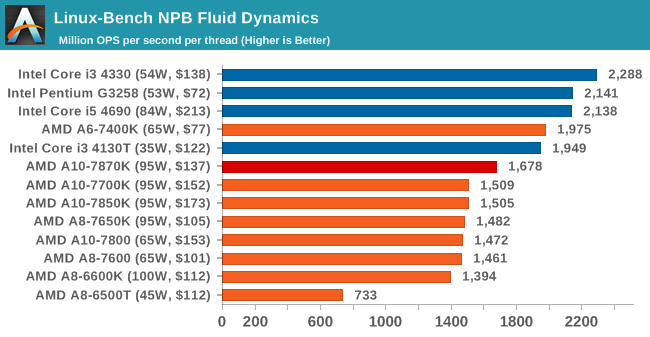
Redis: link
Many of the online applications rely on key-value caches and data structure servers to operate. Redis is an open-source, scalable web technology with a strong developer base, but also relies heavily on memory bandwidth as well as CPU performance.
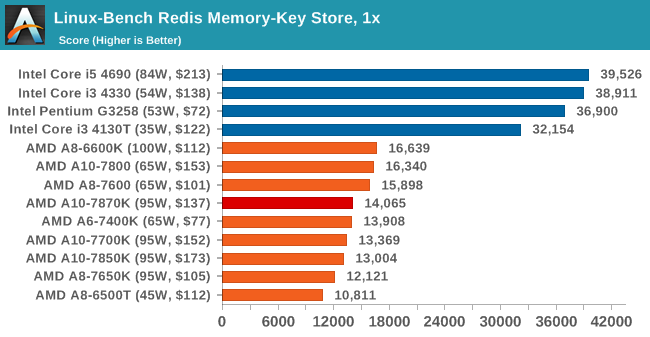

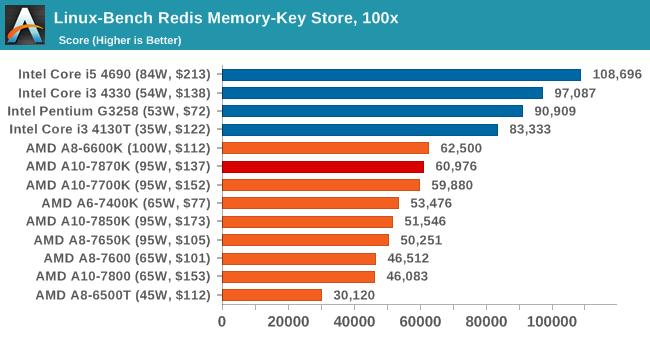










140 Comments
View All Comments
Jimster480 - Tuesday, June 2, 2015 - link
Although why would u want to go the Nvidia route if you have an APU? Why would you want to do dual vendor? The 750 isnt a good value so it only makes sense in applications that need to have a power sipping GPU.RussianSensation - Monday, June 1, 2015 - link
The suggestion of getting a stand-alone budget CPU and a GPU is sound but your recommendation for GTX750 is not. That line is garbage for games for the price.R9 270X costs $125 USD and is 44% faster than a GTX750Ti, which means > 50% faster than GTX750. If gaming is the primary consideration on a budget, under no circumstances should a budget gamer pick a 750/750Ti over the nearly 50% faster $125 270X:
http://www.newegg.com/Product/Product.aspx?Item=N8...
Benchmarks:
http://www.computerbase.de/2015-05/grafikkarten-17...
nikaldro - Monday, June 1, 2015 - link
I know that, but apparently the 260 and 270 line simply don't work well with intel dual cores, as digital foundry found out.meacupla - Monday, June 1, 2015 - link
After playing around with a Pentium G3258, I can clearly say that you're better off with 4 cores, even if 2 of them are virtual.There are now plenty of programs and games that will use up more than 1 thread.
nikaldro - Monday, June 1, 2015 - link
2 haswell cores are just as fast as 2 steamroller modules (wich, i remind, aren't really 4 actual "cores") in multithreaded tasks, and the pentium is MUCH better in single threaded tasks.As for the GPU, the 750 is way better than the APU's iGPU.
It's either a tie or a win for my combo in 90% of the situations.
meacupla - Monday, June 1, 2015 - link
You'll see. The issues with dual cores crop up when those two cores somehow get maxed out or one of them maxes out. 2 cores + 2 virtual cores just has better overhead when one of them gets maxed out.nikaldro - Monday, June 1, 2015 - link
An APU dooesn't have virtual cores. Maybe you are confusing their design with intel's hyperthreading.basically, an APU module is composed of 2 ALUs but only one FPU, so a dual module APU, like this one, does ok in ALU heavy workloads but just fails in FPU heavy ones.
And if a workload can "max out" 2 haswell cores, it sure as hell will kill 2 steamroller modules in almost all cases.
With the pentium you have equal multi thread performance and better single thread performance, as well as a better GPU.
Lolimaster - Monday, June 1, 2015 - link
Try crysis 3 on the pentium and the 870K, use the same dedicated gpu 750, 260, 980ti is you want. With just 2 cores youll get an stutter festival, IPC means nothing when the game actually demand core resources.nikaldro - Monday, June 1, 2015 - link
IPC IS core resources.If core count was all that mattered, we'd use ARM octacores.
silverblue - Tuesday, June 2, 2015 - link
...or AMD FX 8xxx CPUs. Sadly, reality is a mixture of IPC and core count.